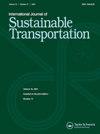Two-stage multilateral trade-based prediction model for freight transport carbon emission of Belt and Road countries along Eurasian Landbridges
IF 3.9
3区 工程技术
Q2 ENVIRONMENTAL STUDIES
International Journal of Sustainable Transportation
Pub Date : 2024-08-02
DOI:10.1080/15568318.2024.2392190
引用次数: 0
Abstract
Global freight distribution patterns have been affected by trading policies and the pandemic outbreak. The Belt and Road Initiative, trade conflicts, and the COVID-19 pandemic have changed the global logistics flow, shifting cargos from maritime and air transport to railway transport along the countries in the Eurasian Landbridge. Though railway freight emits less carbon than road truck transportation, the increased use of railway freight brings in a higher volume of carbon emissions to cities located along the landbridges. Achieving net zero carbon emission is becoming more important, but there is a lack of literature in assessing the environmental impact of cross-border railway logistics transportation among Belt and Road countries. A novel two-stage multilateral trade-based prediction model is developed, integrating a modified gravity model and nonlinear autoregressive neural network for trade and emission forecasting. The model evaluates railway freight along the landbridge over ten years and forecasts the impact of carbon emissions from trading and logistics along the corridor in the subsequent five years. It further analyses the emissions impact of the proposed Third Eurasian Landbridge and the extended Second Eurasian Landbridge. The findings provide insights for the development of railway freight transport, considering trade and logistics flow, carbon emission mitigation strategies, and sustainability impact between China and other Belt and Road countries. While countries such as India and Kazakhstan were forecast to have significant amounts of carbon emissions in the projected period, the rapid growths in locations with smaller emission amounts such as Kunming and Georgia should draw attention and require continuous monitoring.
基于两阶段多边贸易的欧亚大陆桥 "一带一路 "沿线国家货运碳排放预测模型
全球货运配送模式受到贸易政策和大流行病爆发的影响。一带一路 "倡议、贸易冲突和 COVID-19 大流行改变了全球物流流向,使欧亚大陆桥沿线国家的货物运输从海运和空运转向铁路运输。虽然铁路货运的碳排放量低于公路卡车运输,但铁路货运的增加给陆桥沿线城市带来了更高的碳排放量。实现碳净零排放正变得越来越重要,但目前缺乏文献评估 "一带一路 "国家间跨境铁路物流运输对环境的影响。本文建立了一个新颖的基于多边贸易的两阶段预测模型,将修正的重力模型和非线性自回归神经网络整合在一起,用于贸易和排放预测。该模型评估了陆桥沿线十年的铁路货运情况,并预测了随后五年走廊沿线贸易和物流产生的碳排放影响。该模型进一步分析了拟议中的第三欧亚大陆桥和扩展后的第二欧亚大陆桥的排放影响。考虑到中国与其他 "一带一路 "国家之间的贸易和物流流量、碳排放减缓战略以及可持续性影响,研究结果为铁路货运的发展提供了启示。虽然预测印度和哈萨克斯坦等国在预测期内的碳排放量较大,但昆明和格鲁吉亚等排放量较小的地区的快速增长应引起关注,并需要持续监测。
本文章由计算机程序翻译,如有差异,请以英文原文为准。
求助全文
约1分钟内获得全文
求助全文
来源期刊
CiteScore
8.90
自引率
2.60%
发文量
56
期刊介绍:
The International Journal of Sustainable Transportation provides a discussion forum for the exchange of new and innovative ideas on sustainable transportation research in the context of environmental, economical, social, and engineering aspects, as well as current and future interactions of transportation systems and other urban subsystems. The scope includes the examination of overall sustainability of any transportation system, including its infrastructure, vehicle, operation, and maintenance; the integration of social science disciplines, engineering, and information technology with transportation; the understanding of the comparative aspects of different transportation systems from a global perspective; qualitative and quantitative transportation studies; and case studies, surveys, and expository papers in an international or local context. Equal emphasis is placed on the problems of sustainable transportation that are associated with passenger and freight transportation modes in both industrialized and non-industrialized areas. All submitted manuscripts are subject to initial evaluation by the Editors and, if found suitable for further consideration, to peer review by independent, anonymous expert reviewers. All peer review is single-blind. Submissions are made online via ScholarOne Manuscripts.

 求助内容:
求助内容: 应助结果提醒方式:
应助结果提醒方式:


